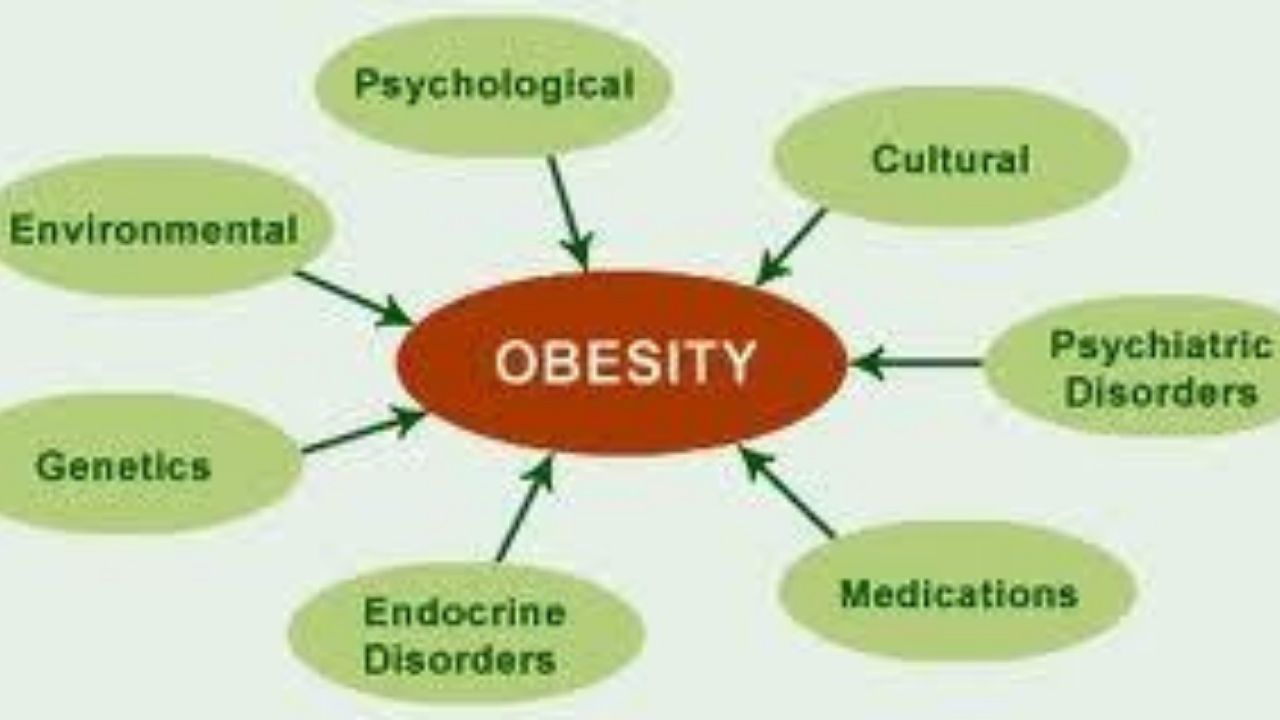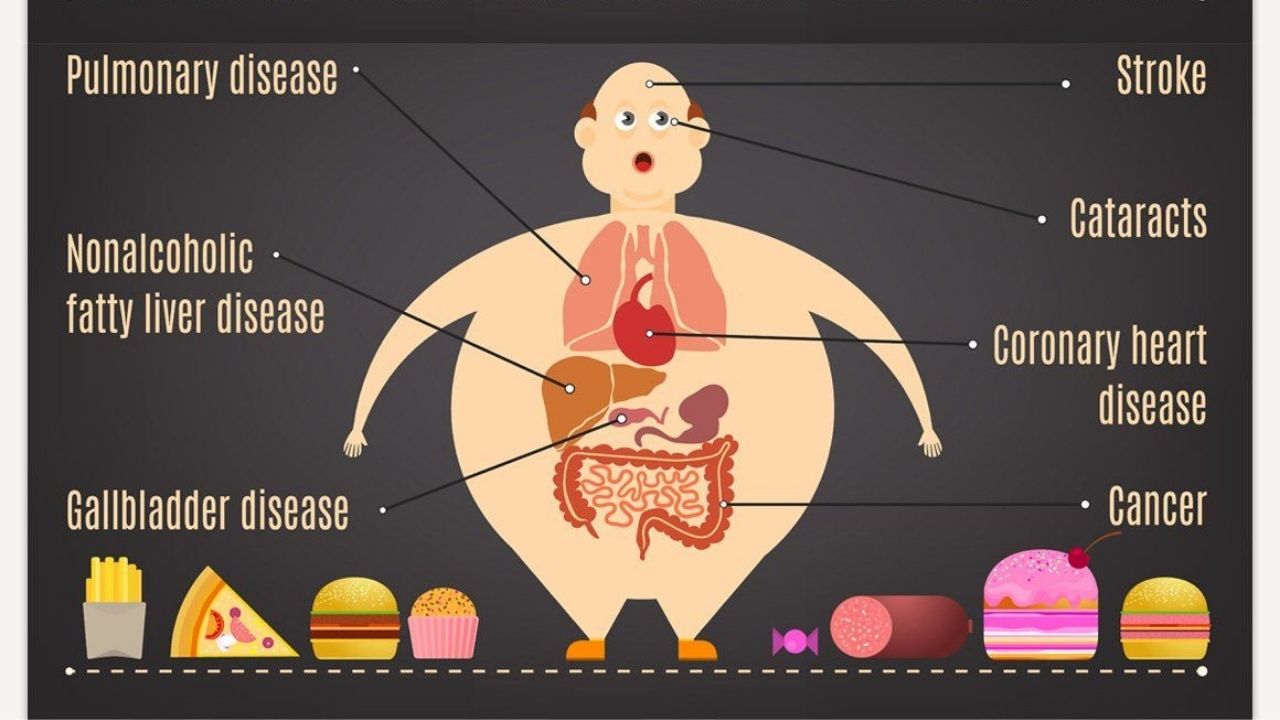Obesity is the excessive presence of adipose tissue in organs and subcutaneous adipose tissue. An excess of body fat is indicated by an increase in body weight of 20% or more in comparison with the average values for a particular height.
Obesity not only causes emotional and mental discomfort, but also causes physical suffering. Increases the risk of developing atherosclerotic changes in blood vessels, hypertension, heart attacks and stroke, diabetes mellitus, cancer, as well as disability in general and even death.
In the treatment of obesity, as in any other disease, an integrated approach is required: adherence to the diet, physical education and psycho-emotional support of the patient.

Body Mass Index (BMI) Formula
In order to find out your BMI, you only need to divide your weight in kilograms by the square of your height in meters.
BMI = WEIGHT / HEIGHT 2
Height is indicated in meters
Classification
Currently, there are many classifications of obesity, which are used in their practice by doctors around the world. The most common way to find out if you are obese is to calculate your body mass index (BMI).
It is applicable to persons from 18 to 65 years old. It is calculated according to the formula: weight in kg / height in meters squared. The level of body weight is determined by the following BMI indicators:
- BMI <18.5 (low) – indicates a lack of body weight;
- BMI from 18.5 to 24.9 (normal) is considered optimal.
- BMI from 25.0 to 29.9 (increased) – indicates overweight and the presence of prerequisites for obesity.
- BMI from 30.0 to 34.9 (high) is considered to be the I degree of obesity.
- BMI from 35.0 to 39.9 (very high) – considered to be II degree obesity.
- BMI of 40 or more (excessively high) – is considered III and even IV degree of obesity (super obesity).
General information
Today, experts around the world recognize the presence of an obesity epidemic in the human population, which is acquiring the character of a pandemic. Every year, more and more overweight people appear on the planet, regardless of age, race and gender.
For many years, WHO has recognized obesity as a risk factor for the development of complications in almost any disease, be it cardiovascular disease, colds, cancer or any other.
Obesity causes

Whatever the prerequisites for the emergence of excess body weight, but almost always the basis is an imbalance between the amount of food entering the body and its consumption for energy and anabolic processes. The body always tries to set aside excess calories “in reserve” in order, if necessary, to use them to maintain vital functions.
The fat cell depot is located in the subcutaneous fatty tissue and the internal organs of the abdominal cavity. Only 5% of obesity cases are caused by metabolic disorders, all other cases occur due to overeating with low physical activity. Obesity can develop for a number of reasons, or with their combination:
- Overeating, especially fatty and carbohydrate foods.
- Violation of the diet: rare and abundant meals, snacks before bedtime.
- Hereditary disorders of the activity of enzymes of lipolysis and lipogenesis.
- Diseases of the endocrine glands (hypothyroidism, polycystic ovaries, pancreatic tumors, Itsenko-Cushing’s disease, etc.).
- Low physical activity.
- Excessive food intake against the background of psychoemotional disorders.
- Taking hormonal drugs (steroids, estrogens, progesterone, insulin).
Pathogenesis
The main hormone that has a lipolytic effect in the body is somatotropic. With its deficiency, insulinemia occurs, the balance of thyroid hormones is disturbed and, as a result, the sensitivity of tissue cells to them changes. These changes occur when eating behavior is disturbed against the background of dysfunction of the hypothalamic-pituitary regulation, which is responsible for the psychoemotional state of the nervous system. The synthesis of adenocorticotropic hormones increases, the synthesis and secretion of cortisol increases, and its metabolism increases.
By the location of body fat in the body, we can talk about the type of obesity:
- Abdominal (upper or android) – characteristic of the male population and is called “apple-shaped”. It is considered the most dangerous type, because with it the deposition of excess fat occurs mainly in the visceral, vital organs, which can lead to damage to the cardiovascular system, respiratory and digestive tract.
- Femoral-gluteal (lower) – characteristic of the female population and is called “pear-shaped”. With this type, excess fat is deposited in the gluteal and thigh regions. Not as dangerous as abdominal, but it can lead to the development of arthrosis of the lower extremities, dysfunction of the spine and lead to venous insufficiency.
- Intermediate (mixed) – fat deposits are evenly distributed throughout the body.
According to the mechanism and reasons for development, obesity can be:
- Primary. Develops against the background of overeating and physical inactivity. Against the background of excessive intake of food in the body, as well as in violation of the diet, the body accumulates excess nutrients in the form of fatty deposits. In this case, obesity is greatly facilitated by the excessive content of fats in food, which cannot be metabolized by the body at once and have to accumulate. Alimentary obesity is often familial in nature and indicates the eating behavior of the family as a whole (evening meals, rare and abundant meals).
- Secondary. It is symptomatic and occurs against the background of various diseases of the nervous system, infectious and parasitic invasions, trauma, tumors or mental disorders. There are also a number of hereditary and genetic diseases, one of the symptoms of which may be obesity: Babinsky-Fröhlich disease, Kleinfelter syndrome, Gelineau syndrome, Lawrence-Myna-Barde-Biedl syndrome and others.
- Endocrine. It occurs against the background of the pathological process in the endocrine glands: hypothyroidism, insulinoma, hypercortisolism, hypogonadism.
Obesity symptoms
The most important symptom of obesity is undoubtedly overweight. It is accompanied, as a rule, by a decrease in the development of the muscular system. Fat deposits are formed in the form of an apron on the abdomen, breeches on the hips, a hump on the neck, false gynecomastia on the chest, a double chin on the face.
Fat deposits are also observed on the arms, back, legs and buttocks. The occurrence of an umbilical, inguinal, and femoral hernia is specific. Patients with pre-obesity, as well as obesity I and II degrees may complain of sweating, irritability, fatigue, shortness of breath, swelling and pain in the spine and joints. Digestive disorders are often observed in such patients.
Patients with grade III-IV morbid obesity have problems in the work of a number of systems and organs: cardiovascular, respiratory, digestive, urogenital.
When examining such patients, they most often find:
- hypertension
- tachycardia,
- respiratory failure
- fatty liver infiltration,
- chronic cholecystitis ,
- pancreatitis,
- arthrosis of the ankle, knee and hip joints,
- menstrual irregularities, up to the development of amenorrhea and infertility,
- eczema, pyoderma, furunculosis, acne caused by increased sweating,
- striae (stretch marks) on the abdomen, hips, shoulders,
- hyperpigmentation in places of folds and friction of the skin,
- obstructive sleep apnea.
Complications

In addition to psychological problems that occur in all overweight patients, they are at risk of developing diseases such as:
- Ischemic heart disease , hypertension, angina pectoris , chronic heart failure , stroke.
- Diabetes mellitus type 2.
- Reflux esophagitis , gastritis , fatty liver hepatosis, cholelithiasis , liver cirrhosis.
- Sleep apnea.
- Pickwick’s syndrome.
- Arthritis and arthrosis of the joints, osteochondrosis of the spine.
- Menstrual irregularities , polycystic ovaries , decreased or absent libido and fertility.
Obese patients are more prone to the risk of developing cancer: breast cancer, ovarian cancer, uterus, prostate, rectal cancer.
Diagnosis
When a patient contacts a doctor, at a consultation, the doctor listens to complaints, collects a detailed anamnesis and objective data. Finds out how long the patient has been obese, with what dynamics he gained weight, whether there is a genetic predisposition to obesity, what eating habits the patient has, whether he has tried to lose weight before and what results and with what measures he was able to achieve the maximum.
The diagnosis and degree of obesity is established by calculating the BMI. Also, to determine the degree of accumulation of fat mass in the subcutaneous fatty tissue, the thickness of the skin fold is measured. To determine the type of obesity, measure the circumference of the chest and waist.
If a woman and a man have a proportion of 0.8 and 1.0, respectively, then we can talk about the presence of abdominal obesity. More accurate information on the degree of obesity affection of internal organs can be obtained using ultrasound, computed and magnetic resonance imaging, densitometry.
In addition to the above research methods, the patient is prescribed additional laboratory and instrumental studies:
- Tonometry.
- ECG and ECHOKG.
- Glucose tolerance.
- Lipidogram.
- Biochemical and clinical blood test.
- General analysis of blood and urine.
Obesity treatment
Each person, in the desire to lose weight, pursues their own specific goals: to reduce health risks, the desire to look better, to increase their performance and others. Depending on the motivation and psycho-emotional mood, each patient is individual, but first of all, the fight against weight begins with diet and physical education.
Diet therapy
Every obese patient should receive a dietitian consultation, during which he is assigned a low-calorie diet. The basic principles of nutrition are explained, which should contain a sufficient amount of proteins, fiber, vitamins and minerals, it is recommended to exclude fats (especially of animal origin), to minimize the consumption of refined carbohydrates.
Food should be prepared in a gentle way, by boiling, steaming or baking. Foods that increase appetite (alcohol, smoked products, seasonings, salty foods) are excluded from the diet. The frequency of food intake should be at least 5-6 times a day, in small portions.
Drug therapy
Treatment of obesity with medications is an extreme measure, and is aimed at suppressing the feeling of hunger, accelerating the appearance of a feeling of satiety, in the presence of psychoemotional disorders, appropriate medications that affect eating behavior can be prescribed. Often, drugs are used that interfere with the absorption of fats and carbohydrates by the body. Drug therapy is carried out for patients with a BMI over 30, and diet and exercise do not give a visible result for 3-4 months.
Forecast and prevention
Modern medicine has made significant advances in the treatment of obesity. Methods and tactics in the fight against obesity are very diverse. The best obesity is considered to be the one that did not exist, and for this it is often enough to maintain a balance between the energy supplied to the body and its consumption.
However, not always, due to maturity, character, mentality or traditions, a person is not always able to realize in time that he has problems with weight. But if a problem has arisen, there are many ways to solve it today, and it is important to approach this in a timely and systematic manner.
Compliance with a diet and good physical activity can reduce the risk of complications and associated diseases. Well-being and satisfaction with the appearance allow a person to maintain their ability to work, social activity, and health.
If obesity nevertheless arises and the fight against it has begun, doctors, as a rule, give a good prognosis for life and work capacity. Much depends, however, on the patient and his initial condition at the time of initiation of treatment.
Surgical treatment of obesity
For many decades, bariatric (metabolic) surgery has been recognized by doctors and patients in the fight against obesity. The methods of surgical treatment of obesity are varied and allow the doctor to choose an individual approach to treatment for everyone. The most commonly used in clinics:
- Installation of an intragastric balloon.
- Stomach banding.
- Longitudinal gastric resection.
- Gastric bypass surgery.
- Biliopancreatic shunting.
All of these methods have proven to be safe. There are indications for each, since the experience of treating patients has already been accumulated over 70 years of the existence of bariatric (metabolic surgery), their effectiveness is different.
The degree of excess weight loss depends on the method of intervention and the patient’s mood, but on average, within six months after the intervention, the patient loses 25-50% of excess fat mass and gradually this indicator increases, reaching a maximum effect by 12 months.
Some operations, such as intragastric balloon placement and gastric banding, have become less common or not used at all by experienced surgeons due to the short time of their positive effect and poor tolerance.
The indication for surgery is a BMI of more than 40 kg / m2, in the absence of the effect of conservative treatment, as well as the presence of type 2 diabetes mellitus (DM) in combination with obesity (as directed by an endocrinologist), even if the BMI is 35 kg / m2 or slightly lower …
Operations are usually performed on the day of admission, you do not need to starve before the operation, you can drink water up to 24 hours before the operation. The patient gets up on his feet on the day of the operation, he starts drinking water after 2-3 hours of awakening from anesthesia, food can be taken on the same day.
Discharge the next day, or in 1-2 days, depending on the volume of the operation. You can start work in 6-7 days. The patient is prescribed a diet, observation of an endocrinologist after 3, 6, 12 months. Assigned control of analyzes and examinations of EGD and ultrasound of the abdominal cavity.